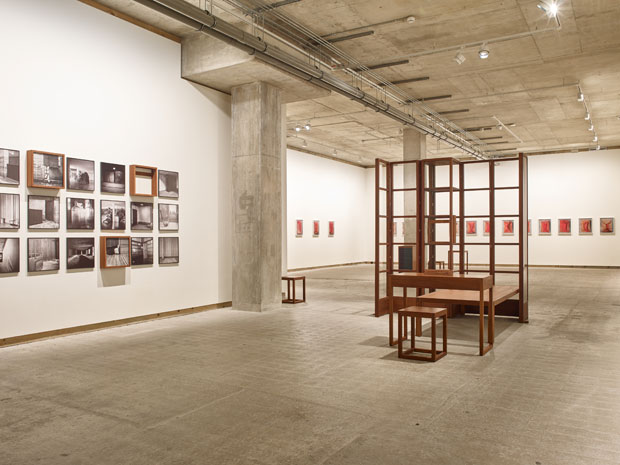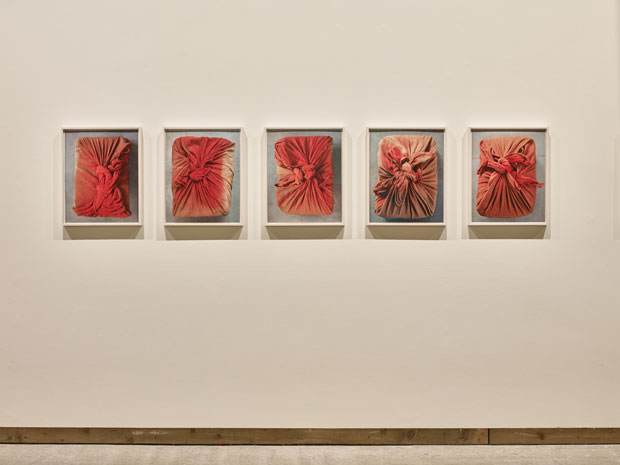For most of her career, Dayanita Singh has placed programmatic disobedience at the core of her approach to photography, challenging the formal qualities of images as well as the way they are exhibited. Amandas Ong speaks to her ahead of her show opening at Frith Street Gallery, London.
Installation view, ‘Dayanita Singh: Museum of Shedding’, at Frith Street Gallery, London. Courtesy the artist and Frith Street Gallery, London. Photo: Steve White

With this exhibition as well as in your previous work, you challenge the physical flatness of photography [the exhibition contains architectural and furniture elements], while completely decontextualising images to present an experience beyond any specific space and time. What are you trying to achieve?
Well, you took the words right out of my mouth! The question is: can photography make visible the invisible, in a poetic sense? If I could describe a photograph entirely in words, why bother making it? Can a photograph go beyond ‘fact-ness’? The burden of photography is that it will record whatever reflects the light. But obsessing over what we record is so boring. Even a machine could do that. I want to take away the realness of photography, take people outside of the image. A successful image does not reveal itself entirely.
Photography has become so static – but if I pull the rug from under the feet of the viewer, present an image that cannot be made sense of, then I have done my work. I may not always succeed, but I want to see if photography can transport me into the places that literature, music and poetry can take us. And these are places that neither words nor pictures can capture. So I suppose what I’m trying to say is that photography really is just a tool, a way of shifting our attention past the surface. Last night I was at a Handel opera, and it took me far beyond where I was sitting in the confines of the Wilton’s Music Hall. And I often wonder if photography has that same possibility.
Installation view, ‘Dayanita Singh: Museum of Shedding’, at Frith Street Gallery, London. Courtesy the artist and Frith Street Gallery, London. Photo: Steve White

Perhaps it’s not that photography is intrinsically static, but rather that given the abundance of images and ease of creating them, people have become much lazier in the way they interact with the visual. You mention literature and the opera – there’s a fair case to be made that these require more effort than the careless gaze we tend to throw upon images.
Yes. I have people telling me ‘but you make such beautiful images’. I’m really sorry, but who cares? My intention is not to make something beautiful, it is to make people step outside of themselves into a different place. Take my Museum Bhavan series, for example, which was shown at the Hayward. It includes photographs from my personal archive as well as those of my mother’s – they’re classified by themes like ‘Vitrines’ and ‘Embrace’, which I had displayed in specially-made cabinets. People have to bend their heads to look at the images, some of which seem barely there. You can’t pull out the images to look at them, so you’re left wondering.
With the Museum of Shedding series in this exhibition, which consists of 73 images, they can either go onto the walls, or into the two storage units and nine boxes that will be shown alongside them. I refuse to disclose any information about where the images were taken, and I’ll leave it entirely up to the viewers’ assumptions. A curtain, a hotel room, a metal pipe – these are not bound by geography or nationality. They exist everywhere and anywhere, in a place built in your imagination. I want to explore the idea of being in a museum where it’s not possible to see a single image, because they’re all tucked away into trunks. The concept of shedding has become very important to me. I still want to make books and create art, but I want to pare my life down to the simplest essentials. We live in really chaotic times now, and one can choose to give up, or go out on the streets and protest. But protesting isn’t me at all, so I am trying to shape my art in a way that reflects the kind of life I wish to live.
Do you specifically harness photography as a form of resistance against Orientalist tropes? You must be really tired of people asking you about what it’s like to be an Indian artist.
Oh, I don’t think anyone really dares to ask me about that anymore, because I’ve made such a huge point about my Indian identity being irrelevant to the heart of what I do. The India that I am inspired by is the India of shedding, of that one cloth that becomes your towel, that becomes your sheet, that becomes your pillow, that becomes the dress you wrap around yourself. I’ve never said this before, but perhaps it is true that my work is Indian in the way I try to think about how objects can be thought of and used in multiple ways, so we reduce what we need. But that’s not the India that people want, and it just doesn’t fit in with the Mickey Mouse dream of India that they have.
You did photojournalism for a number of years, and met people from all walks of life. What has that close scrutiny of the human condition taught you?
I was always struck by how, even though I wasn’t recording their words or interviewing them extensively, they always opened up to me. I was just there to take portraits, so you’d think I’d just press the shutter button and leave, but the conversations could last up to four hours. People often think that Myself Mona Ahmed (2001) is a statement about gender and what it’s like to be a eunuch in India, but it’s really not. We always spoke a lot about love, loss, people coming and going from our lives. Quite early on, I realised that everybody is quite fragile, whether they’re a great society lady or someone like Mona, who lives in a graveyard. I stopped doing family portraits for a while because I would go away after hours of talking to them and find out that there was not a single photograph that could capture everyone’s fragility, fear and pain. I think I can handle it now, though.
Installation view, ‘Dayanita Singh: Museum of Shedding’, at Frith Street Gallery, London. Courtesy the artist and Frith Street Gallery, London. Photo: Steve White

You’ve mentioned a couple of times that Italo Calvino is one of your most beloved writers. In The Adventure of a Photographer, the main character says that ‘in order to really live, you must photograph as much as you can… you must either live in the most photographable way possible, or else consider photographable every moment of your life. The first course leads to stupidity, the second to madness’. Do you think photography is inherently futile?
That’s a beautiful quote, but I think it only makes sense if you think of photography as an end in itself. But if you’re not interested in photography as pure documentation, it frees you to do so much more. My work, Time Measures, is titled after the name of one of Sebald’s poems. I photographed these bundles of documents wrapped in fabric that I found in an archive in India. The viewer never finds out what the documents are or what they look like, and I never did unwrap them either. Does this then mean that the photographs are pointless?
Whenever people ask me how to become a good photographer, I tell them to read, jump into the world of literature. I hand them a copy of Austerlitz by Sebald, and tell them to come back to me when they’re done with it. Nobody ever comes back to me because that’s not the kind of photography they want to do. They’re interested in instant gratification, going around with their big cameras, snapping photographs quickly without thinking. Can we raise the bar higher?
Certainly we can. This morning I was reading an interview with Elena Ferrante, and what she said about the furore surrounding her anonymity reminded me of what you’re trying to do with your work. She borrowed from Calvino, saying: ‘ask me what you want to know, but I won’t tell you the truth, of that you can be sure.’ It seems to be the same logic that governs your practice – conceal or remove anything that can be thought of as unchanging reality.
Absolutely. Now, I’ve never read anything by Ferrante, but perhaps you could tell me where to start. Why should we be so obsessed with the truth, when we could do so much more with everything that falls outside of it?
‘Dayanita Singh: Museum of Shedding’ is at the Frith Street Gallery, London, until 13 January 2017.



